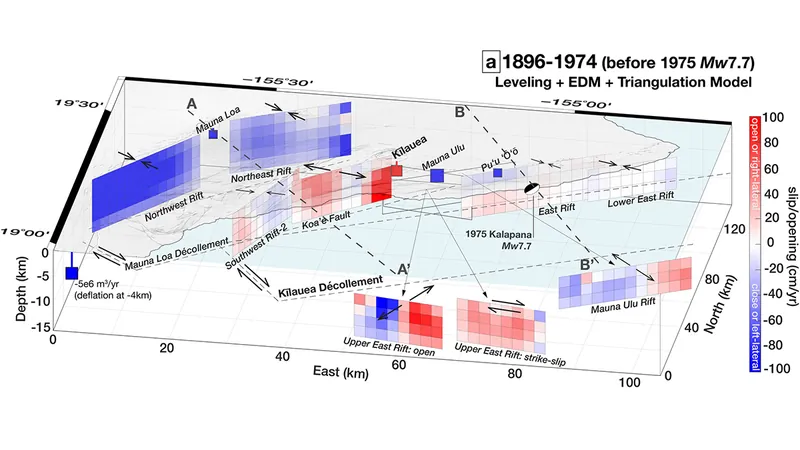
Unveiling 120 Years of Geological Secrets: Kīlauea's Détailment
2024-11-26
Author: John Tan
Introduction
Kīlauea, one of the world’s most active shield volcanoes, continues to captivate researchers and geologists alike with its complex interactions with its neighboring giant, Mauna Loa. Located on the southeastern shore of Hawaii Island, Kīlauea has exhibited a remarkable range of magmatic and seismic activities over the years, including significant earthquakes, tsunamis, and unique slow-slip events. For the past two decades alone, it has been noted that Kīlauea’s south flank is shifting southward at an alarming rate of approximately 6 centimeters annually.
Recent Study Findings
In an intriguing new study published in the Journal of Geophysical Research: Solid Earth, researchers Yong et al. (2024) present a thorough investigation into the deformation and stress changes of Kīlauea’s décollement, analyzing data spanning an impressive 120 years from 1898 to 2018. This extensive dataset offers insight into the geological shifts that occurred pre-dating the powerful 1975 Kalapana earthquake, which registered a magnitude of 7.7.
Methodology
The study employs a range of advanced geodetic techniques, including triangulation, electronic distance measurement, and leveling, to gather data from multiple deformation sources. Particularly noteworthy is the focus on the period leading up to the 1975 earthquake, during which various magma chambers and faults were activated, increasing the overall seismic activity in the region. By correlating this geodetic data with a long-term seismicity catalog tracking events from 1933 to 2018, the researchers bring light to the intricate relationship between volcanic activity and earthquake cycles.
Importance of Research
Such comprehensive studies are not just academically significant; they play a crucial role in enhancing our understanding of the geological processes that govern volcanic behavior. By uncovering these relationships, scientists hope to improve predictive models that can forecast future volcanic eruptions and their potential impact on surrounding communities.
Conclusion
Kīlauea stands as a living laboratory, continually reshaping our understanding of volcanic systems. With Kīlauea's ongoing activity and the release of this essential research, the geology community is keenly watching how these findings might influence future volcanic risk assessment and preparedness strategies.
Stay Tuned!
Stay tuned for more groundbreaking discoveries from the heart of the Pacific!

 Brasil (PT)
Brasil (PT)
 Canada (EN)
Canada (EN)
 Chile (ES)
Chile (ES)
 España (ES)
España (ES)
 France (FR)
France (FR)
 Hong Kong (EN)
Hong Kong (EN)
 Italia (IT)
Italia (IT)
 日本 (JA)
日本 (JA)
 Magyarország (HU)
Magyarország (HU)
 Norge (NO)
Norge (NO)
 Polska (PL)
Polska (PL)
 Schweiz (DE)
Schweiz (DE)
 Singapore (EN)
Singapore (EN)
 Sverige (SV)
Sverige (SV)
 Suomi (FI)
Suomi (FI)
 Türkiye (TR)
Türkiye (TR)